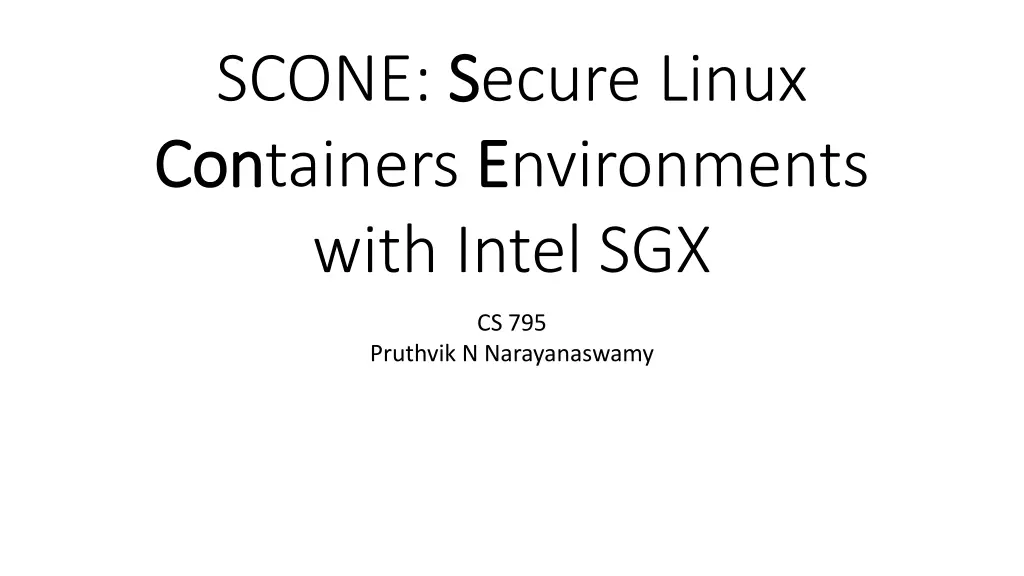
SCONE: Secure Linux Containers with Intel SGX
"Learn about SCONE, a solution enabling secure deployment of unmodified Linux applications in untrusted cloud environments, leveraging Intel SGX for protection against unauthorized access. Explore the benefits, goals, SGX technology, performance considerations, challenges, and the architecture of SCONE."
Download Presentation

Please find below an Image/Link to download the presentation.
The content on the website is provided AS IS for your information and personal use only. It may not be sold, licensed, or shared on other websites without obtaining consent from the author. If you encounter any issues during the download, it is possible that the publisher has removed the file from their server.
You are allowed to download the files provided on this website for personal or commercial use, subject to the condition that they are used lawfully. All files are the property of their respective owners.
The content on the website is provided AS IS for your information and personal use only. It may not be sold, licensed, or shared on other websites without obtaining consent from the author.
E N D
Presentation Transcript
SCONE: S Secure Linux Con Containers E Environments with Intel SGX CS 795 Pruthvik N Narayanaswamy
Motivation Cloud provider does not trust users and use VMS to isolate users from each other and the host. There is only one-way protection and users must implicity trust cloud providers. Enter containers Benefits of low overhead, lightweight, easy deployment etc. Existing container isolation mechanisms focus on protecting the environment from untrusted containers. Users want to protect the confidentiality and integrity of their application data from unauthorized accesses not only from containers, but also from higher-privileged system software, such as
Goals Run Unmodified Linux Applications in containers in an untrusted cloud securely and with acceptable performance.
SGX : Software Guard Extensions The SGX extension adds support for secure enclaves which shield application code and data from access by other software (including higher-privileged software) Inside an enclave both code and data reside in an enclave page cache(EPC) Only enclave can access enclave memory Multiple threads can operate within an enclave, each with its own 4KB thread local storage Some restrictions : syscalls not allowed inside enclaves
Performance Overheads ? Privileged instructions cannot execute inside the enclave, so threads must exit the enclave to make system calls On Intel Skylake CPUs, the EPC size is between 64 and 128 MB, therefore if applications with memory requirements exceeding the size of the EPC must pay for the costly encryption and integrity protection involved in moving pages out to DRAM.
Challenges Challenge 1 : Interface What should be stored in the enclave ?
Scone Architecture Enhanced C library = small TCB Asynchronous system calls and user space threading reduce number of enclave exits Network and file system shields actively protect user data
Shields A file system shied protects the confidentiality and integrity of files, with transparent authentication and encryption. A network shield ensures that all network communications use TLS, terminated inside the enclave. A console shield protects the confidentiality of data sent via the stdin, stdout, and stderr streams.
Integrate with Docker Does not require changes to be made to the Docker Engine or the Docker API Uses a wrapper around the Docker client, Scone client.
Workflow with Docker When a container instance is created from the image, a startup configuration file (SCF) is sent to it via a TLS protected network connection. The SCF contains keys to encrypt standard I/O streams, a hash of the FS protection file and its encryption key, application arguments, and environment variables.
Related Work Software protection against privileged code 1. Initial work such as NGSCB and Proxos executes untrusted and trusted OSs side-by side using virtualization, with security-sensitive applications hosted by the trusted OS. 2. Subsequent work, including Overshadow, SP3, InkTag and Virtual Ghost, has focused on reducing the size of the TCB by directly protecting application memory from unauthorized OS accesses.
Trusted hardware 1. Secure co-processors offer tamper-proof physical isolation and can host arbitrary functionality. 2. Trusted platform modules (TPM) offer tailored services for securing commodity systems. 3. ARM TrustZone has two system personalities, secure and normal world. This split meets the needs of mobile devices in which a rich OS must be separated from the system software controlling basic operations. 4. Intel SGX
References Anatomy of system call from https://www.usenix.org/sites/default/files/conference/protecte d-files/osdi16_slides_knauth.pdf
Thank you Questions ?

